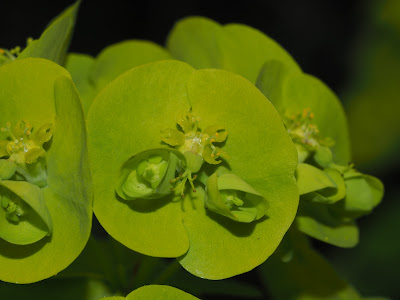Common name: Wood Spurge
Scientific name of the subspecies: Euphorbia amygdaloides subsp. robbiae
Scientific name: Euphorbia amygdaloides 扁桃葉大戟
Genus: Euphorbia 大戟屬
Family: Euphorbiaceae 大戟科, spurge family
Remarks:
Origin: Neophyte (established after 1500 AD). It is a native of N.W. Turkey. It was first cultivated in 1891 and was recorded from the wild since 1977.
Date: 25th March

The yellowish green circular leaves-like structures above just below the cyathium 大戟花序, 杯狀聚傘花序 (the condensed inflorescence in Euphorbia) are also bracts. Enlarged below to see the details of the flower.

For each cyathium, there are four crescent-shaped glands (like horns of a cow), several stamens (they are male flowers actually) and one female flower (you could see the ball-like ovary, the gynophore 雌蕊柄 (the stalk below the ovary) and the style with five stigmas). There are two more cyathiums (bottom one and the left one in the above photo) developing in this photo.
Another photo enlarged below to see the developing cyathium.
The back of the bracts.
Another photo enlarged below to see the male flower.

The structure of one male flower is reduced to one stamen that includes two A - anthers and a F - filament. G is in fact the pedicel of the male flower.





















No comments:
Post a Comment